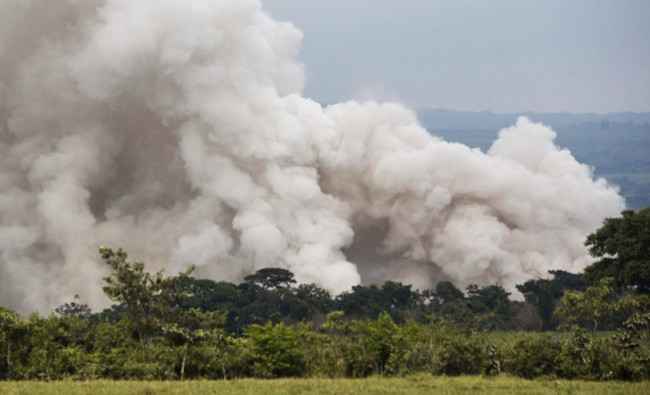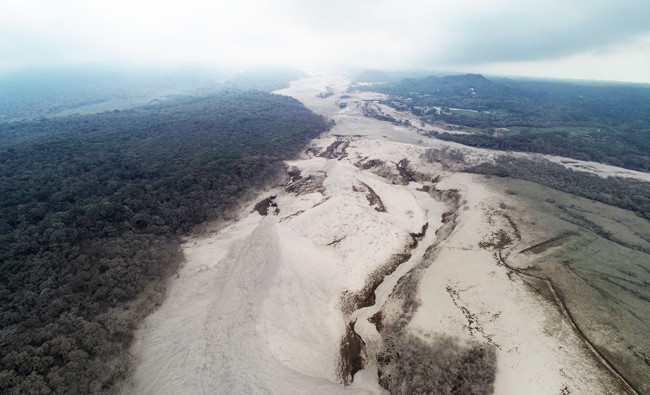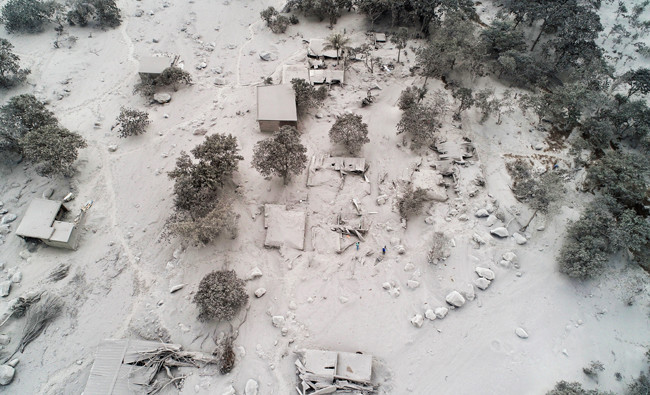ESCUINTLA, Guatemala: Lilian Hernandez wept as she spoke the names of aunts, uncles, cousins, her grandmother and two great-grandchildren — 36 family members in all — missing and presumed dead in the explosion of Guatemala’s Volcano of Fire.
“My cousins Ingrid, Yomira, Paola, Jennifer, Michael, Andrea and Silvia, who was just 2-years-old,” the distraught woman said — a litany that brought into sharp relief the scope of a disaster for which the final death toll is far from clear.
What was once a collection of verdant canyons, hillsides and farms resembled a moonscape of ash, rock and debris on Tuesday in the aftermath of the fast-moving avalanche of super-heated muck that roared into the tightly knit villages on the mountain’s flanks, devastating entire families.
Two days after the eruption, the terrain was still too hot in many places for rescue crews to search for bodies or — increasingly unlikely with each passing day — survivors.
By afternoon a new column of smoke was rising from the mountain and Guatemala’s disaster agency said volcanic material was descending its south side, prompting an evacuation order and the closure of a nearby national highway. Rescuers, police and journalists hurried to leave the area as a siren wailed and loudspeakers blared, “Evacuate!“
On Sunday, when the volcano exploded in a massive cloud of ash and molten rock, Hernandez said her brother and sister ran to check on their 70-year-old grandmother on the family’s plot of land in the village of San Miguel Los Lotes.
“She said that it was God’s will, she was not going to flee,” Hernandez said. “She was unable to walk. It was hard for her to get around.”
Her brother and sister made it to safety, but their grandmother has not been seen again.
Hernandez and her husband, Francisco Ortiz, survived because they moved out of Los Lotes just two months ago to begin a new life on a small plot of land.
The couple has been staying at a Mormon church in the nearby city of Escuintla and going to a morgue there to await news. So far only the body of one relative, her 28-year-old cousin, Cesar Gudiel Escalante, has been recovered and identified.
“The people ended up buried in nearly 3 meters of lava,” Ortiz said. “Nobody is left there.”
Other families experienced similar tragedies.
As President Jimmy Morales toured the area and met with survivors on Monday, a woman begged him to help her loved ones in Los Lotes.
“Mr. President, my family is missing. Send a helicopter to throw water over them because they are burning,” she said. “I have three children, a grandchild, and all my brothers, my mother, all my family are there. ... More than 20 have disappeared.”
The fast-moving flows with temperatures as high as 1,300 degrees Fahrenheit (700 Celsius) and hot ash and volcanic gases that can cause rapid asphyxiation caught many off guard.
On Tuesday, it was clear that the official death toll of at least 70 was sure to climb and fears spread that anyone still stuck in the buried houses was dead and would remain entombed there.
At a roadblock, Joel Gonzalez complained that police wouldn’t let him through to see his family’s house in the village of San Juan Alotenango, where his 76-year-old father lay buried in ash along with four other relatives.
“They say they are going to leave them buried there, and we are not going to know if it’s really them,” the 39-year-old farmer said. “They are taking away our opportunity to say goodbye.”
A spokesman for Guatemala’s disaster agency, Conred, said that once it reaches 72 hours after the eruption, there will be little chance of finding anyone alive.
“We don’t rule out the possibility of some person alive, but the condition in which the homes are makes that possibility pretty unlikely,” said the spokesman, Juan Sanchez, adding that some of the ash was still at temperatures between 750 and 1,300 degrees Fahrenheit (400 and 700 degrees Celsius).
In the devastated town of El Rodeo, gray soot coated trees and homes and an ash-covered deer lay dead in the debris. Rescuers wearing hard hats, masks and goggles used shovels to dig through homes, unearthing at least one body burned beyond recognition.
Amid the destruction, there was one glimmer of hope: The rescue of a black-and-white dog found alive in a home where four people lay dead.
“He is called Rambo,” said volunteer firefighter Sergio Vazquez, who carried the dog on his shoulders to safety. “It may be that this dog no longer has a family.”
Vazquez had no explanation for how the dog survived while the people died.
Sanchez, the Conred spokesman, said many dogs and cats had been rescued with burns on their paws from the mud and ash, some blinded from the volcanic gases.
“Animals have a different sort of resistance ... and different behavior when it comes to finding refuge,” Sanchez said.
Only 17 of the bodies recovered so far have been identified due to the extreme heat that charred their features and burned off fingerprints, and authorities hope other means such as DNA testing can help.
Authorities say at least 46 people were injured in the eruption, and 12 shelters were housing 1,877 people.
The Guatemalan military said a US Air Force plane was flying in Tuesday to take about a half-dozen children who suffered burns for treatment in Galveston, Texas.
Lacking electricity in the hardest hit areas, emergency crews were carrying out rescue efforts during daylight hours and calling them off for safety reasons when darkness fell.
As dawn broke Tuesday, the volcano continued to rattle with what Guatemala’s Volcanology Institute said were eight to 10 moderate eruptions per hour — vastly less intense than Sunday’s big blasts.






























